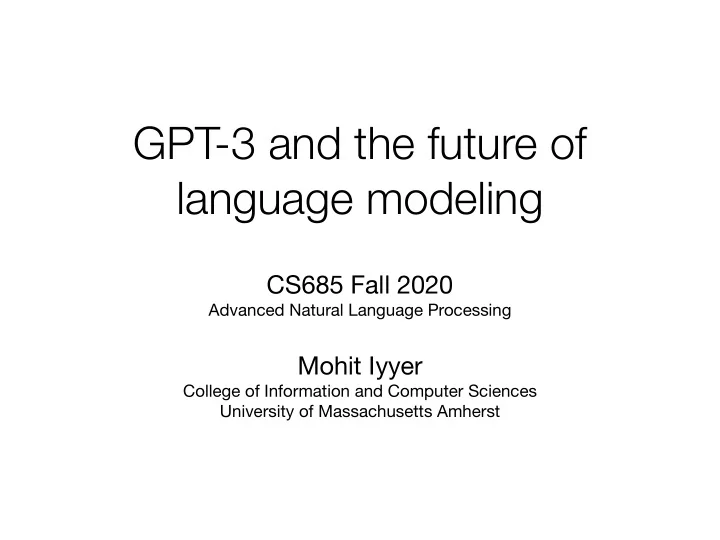

GPT-3 and the future of language modeling CS685 Fall 2020 Advanced Natural Language Processing Mohit Iyyer College of Information and Computer Sciences University of Massachusetts Amherst
Stu ff from last time • How is the [CLS] token pretrained (e.g., how does it learn a contextualized vector during pretraining?) Is it shared across all pretraining sentences? • We get multiple embeddings per token in ELMo and BERT (di ff erent layers), how do we choose which to use? • Project proposal feedback by the end of the week! • Practice exams available on Piazza
Today, an alternative to “pretrain+finetune”, which involves simply getting rid of fine-tuning “Language models are few-shot learners”, Brown et al., 2020
The language model “scaling wars”! ELMo: 93M params, 2-layer biLSTM BERT-base: 110M params, 12-layer Transformer BERT-large: 340M params, 24-layer Transformer
The language model “scaling wars”! ELMo: 93M params, 2-layer biLSTM BERT-base: 110M params, 12-layer Transformer BERT-large: 340M params, 24-layer Transformer
The language model “scaling wars”! ELMo: 93M params, 2-layer biLSTM BERT-base: 110M params, 12-layer Transformer BERT-large: 340M params, 24-layer Transformer
The language model “scaling wars”! ELMo: 1B training tokens BERT: 3.3B training tokens RoBERTa: ~30B training tokens
The language model “scaling wars”! ELMo: 1B training tokens BERT: 3.3B training tokens RoBERTa: ~30B training tokens
The language model “scaling wars”!
The language model “scaling wars”! Log scale!
so… what does all of this scaling buy us?
Downstream training data Downstream test data
No fine-tuning!!! Literally just take a pretrained LM and give it the following prefix: “Translate English to French: cheese =>”
No fine-tuning!!! Literally just take a pretrained LM and give it the following prefix: “Translate English to French: sea otter => loutre de mer, cheese =>”
No fine-tuning!!! Literally just take a pretrained LM and give it the following prefix: “Translate English to French: sea otter => loutre de mer, peppermint => … (few more examples), cheese =>” Max of 100 examples fed into the prefix in this way
How does this new paradigm compare to “pretrain + finetune”?
TriviaQA
What does this mean?
What about translation? (7% of GPT3’s training data is in languages other than English)
Improvements haven’t plateaued!
What about reading comprehension QA?
Struggles on “harder” datasets
Data contamination
So… should we drop everything and focus all of our efforts on training bigger and bigger LMs? “Climbing towards NLU…”, Bender & Koller, ACL 2020
Distinction between “form” and “meaning” • Form : characters / words making up some text (or sounds etc for spoken language) • Meaning : How the form of a given text relates to something outside of language (e.g., grounded in some world)
Distinction between “form” and “meaning” • Thought experiment (from Emily Bender): • Training data: All well-formed Java code on GitHub, but only the text of the code; no output; no understanding of what unit tests mean • Test input : A single Java program, possibly even from the training data • Expected output : Result of executing that program
Distinction between “form” and “meaning” • Thought experiment (from Emily Bender): • Training data: All well-formed Java code on GitHub, but only the text of the code; no output; no understanding of what unit tests mean • Test input : A single Java program, possibly even from the training data • Expected output : Result of executing that program What’s missing is the meaning … what is the program supposed to do, given just the form (code)?
The octopus test A B Same… luckily I’m stranded we can talk to here… it sucks each other!
The octopus test A B Any plans to Nope. Just escape? gonna lie here. O
The octopus test So where are you from? Los Angeles, it’s got great weather
The octopus test Help! I’m being chased by a bear! All I have is a stick, what do I do? Not sure, sorry! (No idea what a bear or stick is…)
O did not learn “meaning” • O only observed form, without any grounding in the world on these islands • A could find meaning from O ’s utterances, even though O did not “understand” what it was saying • What if B didn’t know what a bear was either? They might respond similarly to O . However, B can ground their responses in their own world/experience, and as such are formulating their response totally differently from O
So what now? • We need more datasets that are grounded in different modalities and ways of interaction! • We need ways to test a model’s ability to generalize or adapt to new tasks • Take some inspiration from human language learning: children do not learn from form alone, why should we force our machines to do so?
Recommend
More recommend